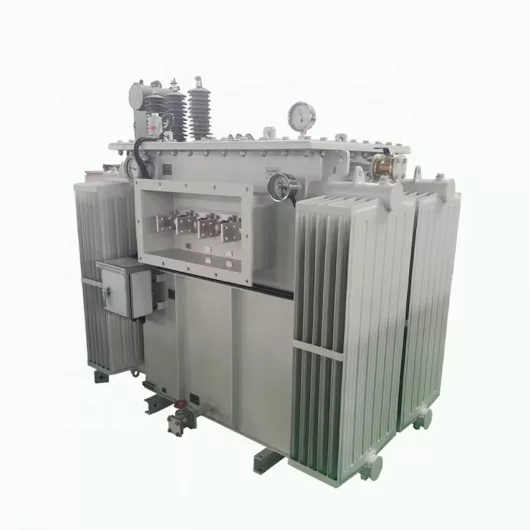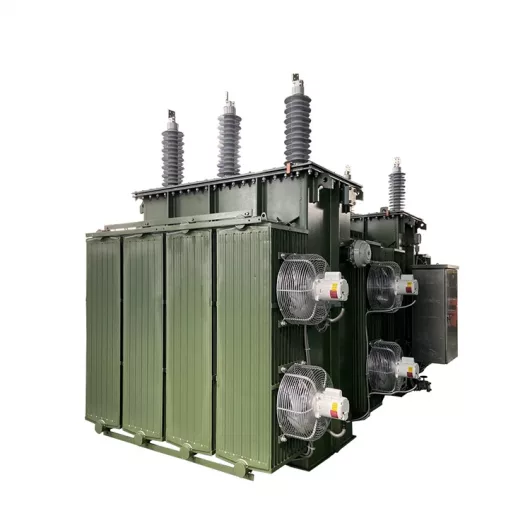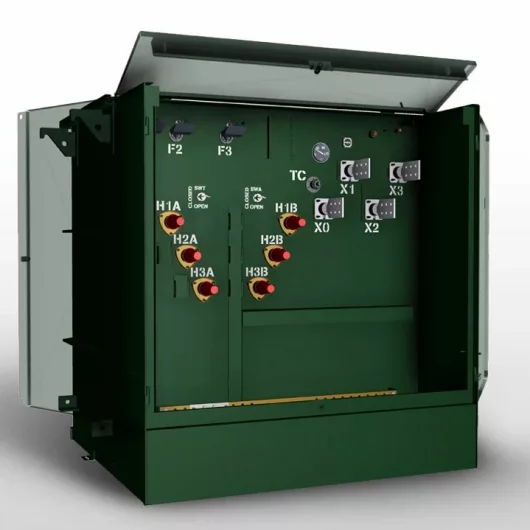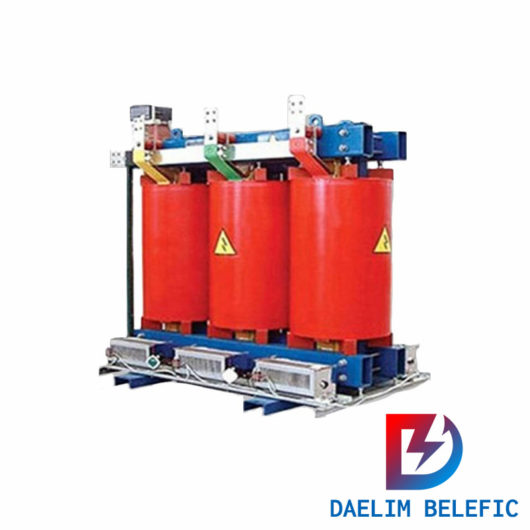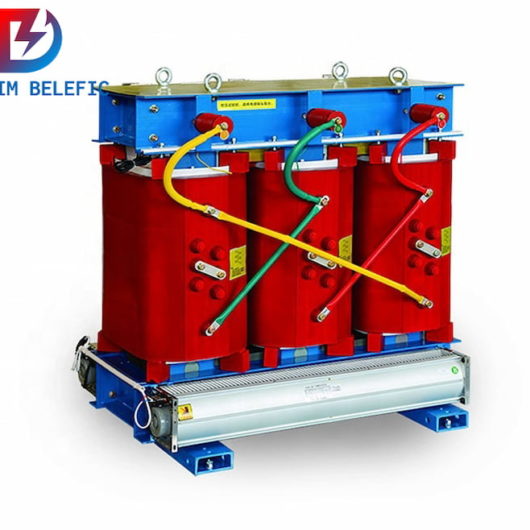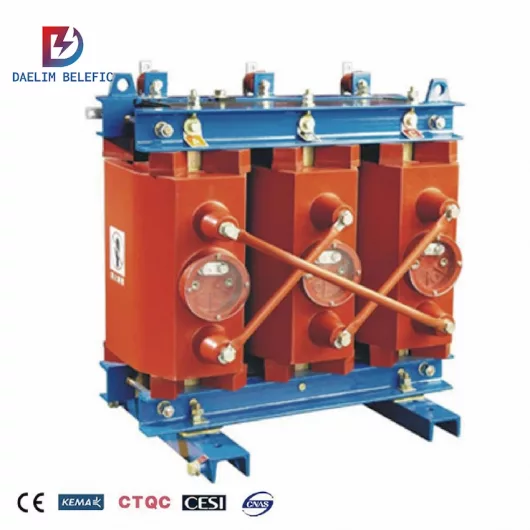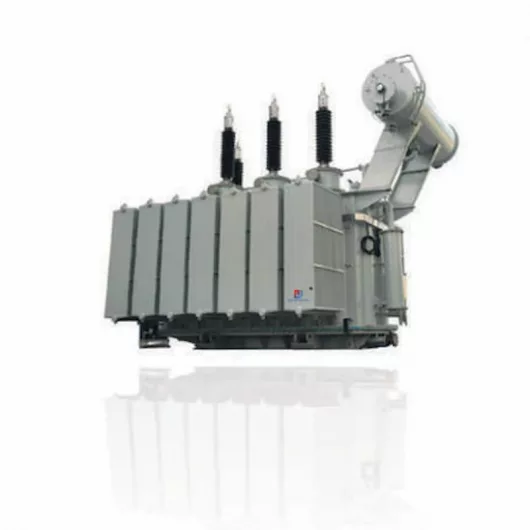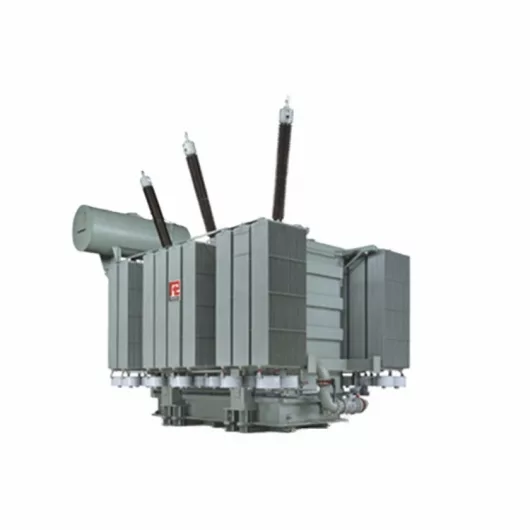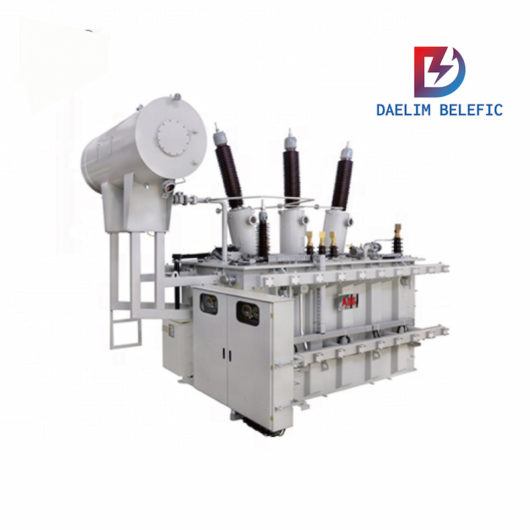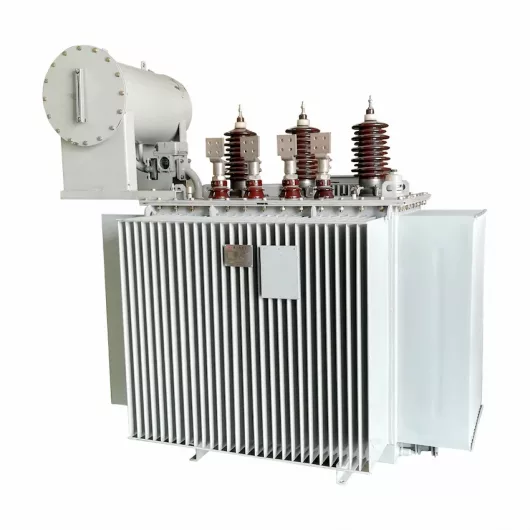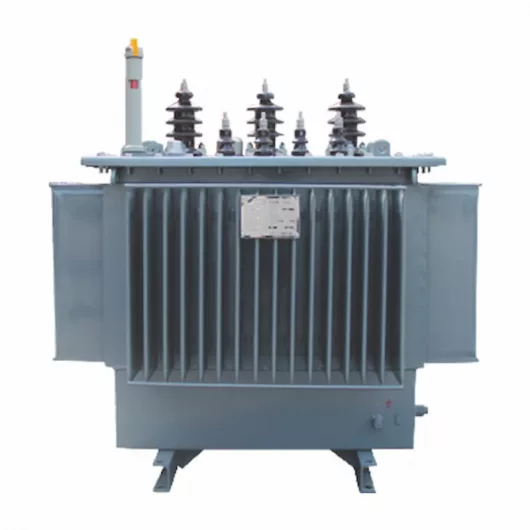ELECTRIC, WITH AN EDGE
The single-phase pad-mounted transformer is designed to improve performance in terms of rated KVA, compact dimensions, lower weight, safety and sustainability. There is no distribution room, can be placed directly indoors or outdoors, can also be placed on the streets and green belt and reliably ensure personal safety, both the power supply facilities, but also decorate the environment. It is low-profile, compartment type transformer, which supplies suitable for outdoor mounting on pads without additional protective enclosures, and meet the following standard: IEC60076, ANSI/IEEEC57.12.00, C57.12.38, C57.12.90 .
1. The high voltage porcelain sleeve installed in the box cover is equipped with ring terminal blocks, suitable for aluminum or copper wires.
2. The box cover adopts ring-shaped overlock structure, which has uniform strength and reliable sealing.
3. The low voltage cover and box wall terminal are ring-shaped bolts, and the surface is tin-plated.
4. 4. Equipped with self-sealing pressure release valve.
5. The single phase pad-mounted type transformer is manufactured in accordance with ANSI standards.
6. High voltage with plug-in fuse.
7. Double voltage switch can be selected for high voltage, which is suitable for different power grid.
8. With pressure release valve, safe and reliable.
9. The single-phase pad-mounted transformer hook and support frame are produced according to American standards.
10. The ground terminal is American and can withstand large currents.
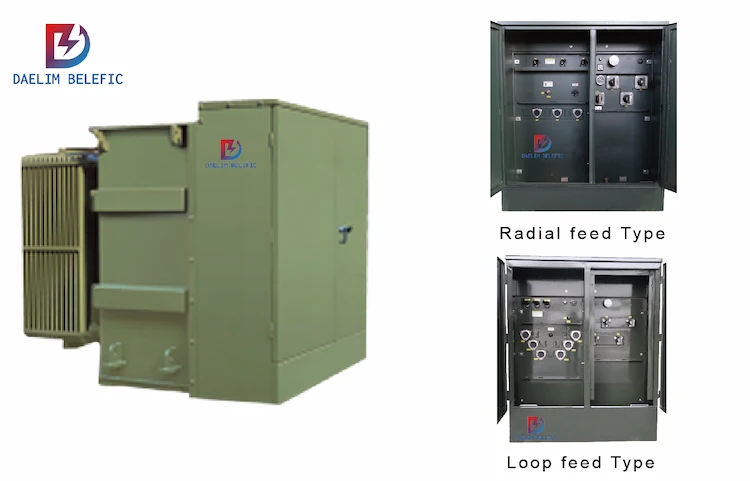
| (kva) Rated power | (v) High voltage | (v) Low voltage | No-load loss (W) | Loss on load (W) |
| 15 | 34500/19920/13800/7957/13200/7620 or others | 120-240 240-480 347 600 | 50 | 195 |
| 25 | 80 | 290 | ||
| 37.5 | 105 | 360 | ||
| 50 | 135 | 500 | ||
| 75 | 190 | 650 | ||
| 100 | 210 | 850 | ||
| 167 | 350 | 1410 |
| (kva) Rated power | Dimensions (mm) | Weight (kg) | |||
| W | D | H | Wight Oil | Total Wight | |
| 15 | 610 | 740 | 840 | 45 | 294 |
| 25 | 610 | 740 | 840 | 68 | 362 |
| 37.5 | 610 | 760 | 840 | 75 | 476 |
| 50 | 610 | 810 | 840 | 93 | 553 |
| 75 | 610 | 860 | 840 | 132 | 672 |
| 100 | 740 | 940 | 910 | 141 | 742 |
| 167 | 760 | 1190 | 910 | 207 | 952 |
1. The altitude does not exceed 1500m
2. Use the ambient temperature +40℃—-20℃
3. The annual average humidity does not exceed 90
4. Both indoor and outdoor
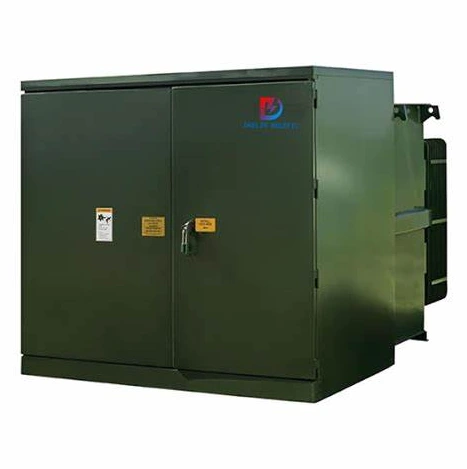
One of the greatest advantages of single-phase pad-mounted transformers is their durability. They are built to withstand the harshest outdoor environments and are resistant to corrosion, moisture and other environmental factors. This makes them an ideal solution for applications where reliability is critical.
Another advantage of pad-mounted transformers is their compact size. They are designed to be placed on a small concrete pad, making them ideal for use in confined spaces or in areas where space is at a premium. In addition, these transformers are designed to be easy to install, which can save you time and money in installation costs.
Single-phase pad-mounted transformers are an essential component of the power grid. They are used to transmit and distribute electrical power at low voltage, typically up to 34.5 kV. These transformers are installed in subway concrete vaults or on concrete pads, and are designed to be compact, efficient and low maintenance.
Here are some of the advantages of using single-phase pad-mounted transformers:
1. space saving: single-phase pad-mounted transformers are designed to be compact and require very little space. This makes them the ideal choice for areas where space is limited, such as urban areas or densely populated suburbs.
Easy Installation: These transformers are easy to install, and can be installed above or below ground level, depending on your needs. They are designed to be self-contained, requiring very little additional equipment or infrastructure to operate.
Low maintenance: Single-phase pad-mounted transformers are designed to require little maintenance. They require very little attention once installed and are designed to be highly reliable.
4.Efficient: These transformers are designed to be highly efficient, with very low losses. This means that they are capable of supplying power to the grid with minimal waste or inefficiency.
5.Customizable: The single-phase pad-mounted transformers are highly customizable, and can be designed to meet your specific power distribution needs. They are available in a wide range of sizes and configurations, so you can choose the transformer that best suits your needs.
Cost-effectiveness: Single-phase pad-mounted transformers are a cost-effective option for power distribution. They require minimal maintenance and have a long service life, which can help keep your operating costs low over time.
In summary, single-phase pad-mounted transformers are a reliable, efficient and cost-effective solution for power distribution. They offer a number of advantages, such as easy installation, low maintenance and customizable configurations. If you need a power distribution solution, a single-phase pad-mounted transformer may be the right choice for your needs.
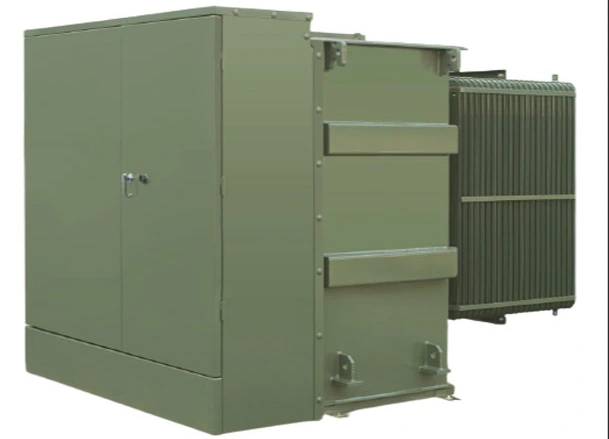
When choosing a single-phase pad-mounted transformer, there are a few key specifications to consider. The first is the kVA rating of the transformer, which is a measure of the transformer’s ability to handle the electrical load. Other specifications to consider are the transformer’s voltage rating, frequency and temperature rating.
In addition to these basic specifications, you should also consider the dimensions and weight of the transformer. The size of the transformer will depend on the specific application and it is important to ensure that it fits in the available space. The weight of the transformer is also an important consideration, as it will affect the transportation and installation of the transformer.
Single-phase pad-mounted transformers are used to convert high-voltage power to low-voltage power, which is suitable for domestic and industrial use. These transformers are designed to be installed outdoors and are usually placed on a concrete pad or other suitable surface.
Specifications for single-phase pad-mounted transformers may vary depending on the specific model and intended use. Below are some key specifications to consider:
When selecting a single-phase pad-mounted transformer, it is important to consider these specifications to ensure that the transformer is suitable for the intended application. It is recommended that a qualified electrician or transformer supplier be consulted to determine the proper specifications for your specific needs.

The cost of a single-phase pad-mounted transformer will depend on several factors, such as the specifications, size and weight of the transformer. In general, these types of transformers are more expensive than their pole-mounted counterparts due to their durability, reliability and ease of installation. However, the long-term benefits of a pad-mounted transformer can offset the initial investment.
Single-phase pad-mounted transformers are an important component of electrical distribution systems. They are widely used in residential, commercial and industrial areas, where they reduce the voltage of main power lines to a lower voltage suitable for use in buildings or equipment. If you are considering purchasing a single-phase pad-mounted transformer, it is important to consider its cost.
The cost of a single-phase pad-mounted transformer depends on several factors, such as its size, capacity and features. In general, the larger the transformer and the more features it has, the more expensive it will be. However, cost is not the only factor to consider when purchasing a transformer, as the reliability and efficiency of the equipment can affect long-term costs.
To get an accurate estimate of the cost of a single-phase pad-mounted transformer, it is best to consult a reputable transformer manufacturer or supplier. They can provide detailed information on the price range of transformers based on their specifications, including size, capacity and other features.
It is important to keep in mind that while the cost of a single-phase pad-mounted transformer may initially seem high, it is a long-term investment that can save money in the long run. High-quality transformers are designed to be durable, reliable and efficient, which can reduce maintenance and operating costs over time. In addition, transformers with advanced features, such as remote monitoring and control, can help avoid downtime and improve overall system performance.
In general, when considering the cost of a single-phase pad-mounted transformer, it is important to balance the upfront costs with the long-term benefits. Investing in a reliable, high-quality transformer can save money in the long run, while cutting corners and buying a cheaper, lower-quality transformer can mean higher costs and more downtime down the road.
A single-phase pad-mounted transformer is a kind of electrical transformer designed for installment on a concrete pad or foundation. It plays an important duty in power distribution, specifically in locations where subway electrical distribution is liked.
Style and building and construction: These transformers are confined in a tough, weatherproof enclosure, guaranteeing their security and longevity. They are particularly designed to be meddle resistant, making them optimal for public areas.
Performance: The key function of a single-phase transformer pad is to convert high-voltage power from power lines into low-voltage electrical energy ideal for property or business use.
Advantages: One of the primary advantages of using a single-phase pad-mounted transformer is its portable layout, which enables easy installment and minimal aesthetic influence on the landscape.
Security: These transformers are furnished with security functions that protect versus electric mistakes, guaranteeing a consistent and trustworthy power supply.
Upkeep: Thanks to their encased design, single-phase pad-mounted transformers require very little upkeep, making them a cost-effective option for power distribution.
Renewable energy combination: These transformers can be integrated with renewable energy sources, such as photovoltaic panels, to supply a sustainable energy solution.
167 kva pad-mounted transformer: This is a details transformer dimension that represents its capability. The 167 kva score suggests the maximum amount of power it can take care of.
Applications: Single-phase pad-mounted transformers are typically utilized in suburbs, business structures and industrial centers. They are particularly advantageous in areas where above power lines are not possible.
Customization: Manufacturers, such as Daelim, offer customized services customized to particular market requirements, making certain maximum efficiency and performance.
Worldwide requirements: These transformers are manufactured in accordance with different worldwide requirements, such as ANSI, IEC and IEEE. This guarantees their top quality and reliability in various atmospheres.
The size of a single-phase pad-mounted transformer plays a crucial function in establishing its ability, performance and suitability for details applications.
The dimension of a transformer is commonly connected to its capacity and power, as shown by its kVA rating. For example, a bigger single-phase metro transformer generally has a greater kVA ranking, demonstrating its capability to handle higher quantities of power.
Spatial restrictions: The substantial measurements of the transformer can affect its deployable areas. Bulkier transformers may demand ample room and a tough base.
Warm dissipation: Larger transformers have a bigger surface, which can assist dissipate warm more effectively, guaranteeing that the transformer stays within safe operating temperature levels.
Efficiency: Size can influence transformer performance. Although bigger transformers can manage even more power, they can additionally have greater losses. It is essential to balance dimension with effectiveness demands.
Price: Generally, larger transformers are much more costly because of the better amount of materials and technology integrated.
Service life: A transformer that is the ideal dimension, neither too big nor too small for its designated application, will commonly have a much longer life span, as it will certainly not be continuously strained or underutilized.
Safety: Oversized transformers can cause ineffectiveness and potential security hazards, while small transformers can come to be overloaded.
Integration with systems: Size determines how the transformer incorporates with various other electric systems. For instance, the expense of a single-phase pad-mounted transformer can differ depending on its dimension and the intricacy of the systems for which it is planned.
Environmental influence: Larger transformers can have a much more considerable environmental effect, both in regards to physical area and possible electromagnetic exhausts.
Personalized solutions: Businesses like Daelim provide individualized remedies, ensuring that the transformer’s dimensions align perfectly with the client’s demands, improving efficiency and expense financial savings.
The price of transformers commonly boosts with their capacity to take care of higher power lots, such as the 167 kVA single-phase pad-mounted transformer, which has a higher kVA rating than smaller sized transformers.
The option of materials, such as the core and coil, plays an essential role in determining the cost because of their top quality and kind.
Technical enhancements: Sophisticated features, consisting of the capability for remote observation or synchronization with renewable resource systems, can cause increased expenses.
Reputation and consistency: Well-known brand names with a background of supplying premium items can warrant premium pricing.
Customization: Customized options offered by firms like Daelim to address the unique demands of various industries have the potential to impact expenses.
The total cost of setup might boost because of variables like obtaining the site prepared, labor charges, and the requirement for added tools.
Upkeep and guarantee: Transformers with prolonged guarantees or maintenance packages included may have a greater initial cost, however can save cash over time.
Performance: High-efficiency transformers, while potentially extra expensive at first, can result in energy expense financial savings gradually.
Accreditations: Transformers that meet worldwide requirements such as ANSI, IEC and IEEE can be greater valued due to the extensive testing and quality assurance they undertake.
The cost of a transformer can vary based upon where you buy it, given that transportation, taxes, and import/export costs can vary from area to area or nation to country.
Single-phase and three-phase pad-mounted transformers perform the exact same primary feature, but have unique distinctions:
Stage setup: The most obvious difference is the number of phases. Single-phase transformers deal with electrical energy in a single rotating current, while three-phase transformers manage electrical energy in three separate rotating currents.
Power distribution: Three-phase transformers are frequently utilized in commercial settings because of their ability to distribute large amounts of power effectively.
Power Savings: Industrial settings where substantial tools require consistent power can profit significantly from using three-phase transformers, which are normally more effective than single-phase transformers, causing reduced power intake and expense.
Size and weight: Three-phase transformers are typically bigger and larger than their single-phase counterparts due to the fact that they take care of more power and have more parts.
Rate: Three-phase transformers typically include a higher cost contrasted to single-phase transformers due to their larger dimension and capability.
Applications: Single-phase transformers are normally made use of in houses and small businesses, while three-phase transformers are much more usual in industrial setups and huge industrial establishments.
These transformers are capable of handling greater voltage needs, that makes them an excellent selection for sturdy applications and circumstances that call for a great deal of power.
Toughness: Given their style and meant use in demanding atmospheres, three-phase transformers are developed to be incredibly long lasting.
Safety and security functions: Both types of transformers come furnished with security functions, however three-phase transformers might have extra securities as a result of the greater voltages and currents they deal with.
Customization: Both single-phase and three-phase transformers can be personalized to satisfy specific needs. As an example, Daelim offers custom-made services for both kinds, ensuring optimal efficiency.
Specs give comprehensive info on a product’s layout, ratings and criteria. For single-phase pad-mounted transformers, these specifications consist of:
The power score in kilovolt-amperes (kVA) shows how much electricity the transformer can handle. As an example, a pad-mounted transformer for single-phase use can take care of approximately 167 kVA.
Transformer voltage ability: Defines the optimum voltage levels that the transformer can manage, both on the input (main) and output (additional) sides.
Frequency: Transformers usually run at a regularity of 50 Hz or 60 Hz, depending upon the region.
Heat dissipation method: Details the transformer’s heat dispersion procedure, such as being immersed in oil or cooled down by air.
Impedance is a step of just how immune a transformer is to the flow of existing, normally offered as a percentage value.
Temperature level increase: Specifies the optimum permitted temperature increase when the transformer goes to full load.
Performance: Indicates the performance with which the transformer transforms input power to output power.
Protective Measures: Describes numerous safety and security features, consisting of circuit breakers and surge protectors, that are already in position to prevent damage or damages.
Room kind: Describes the sort of real estate or unit that protects the transformer from exterior components.
Conformity and criteria: The transformer satisfies numerous worldwide criteria, consisting of ANSI, IEC, and IEEE, ensuring its high quality and integrity.
How can I choose the single-phase pad-mounted transformer that ideal fits my requirements?
Picking the ideal single-phase transformer is vital for reliable power circulation and safety. This guide will help you make a notified choice:
Examine your power requires by calculating the overall power needed for the particular area or devices you intend to supply power to. This examination will certainly help you in picking a transformer that has the appropriate kVA rating.
Make sure compatibility in voltage levels: Verify that the transformer’s input and outcome voltage capabilities align with your required source and location voltage specifications.
Location and setup: If space is limited, think about the physical dimensions of the transformer. Some transformers, such as single-phase pad-mounted transformers, are designed to match particular areas.
Security and compliance: Choose transformers that fulfill worldwide requirements such as ANSI, IEC and IEEE. This ensures quality, safety and reliability.
High-efficiency transformers might be much more costly at the start in energy cost savings with time
Air conditioning method: Choose between oil-immersed transformers or air-cooled transformers based upon
Customization: For consumers with details demands, Dael offer customized services that to satisfy those needs.
Budget: While it is essential to buy high quality, maintain your budget in mind. In some cases an extra costly transformer may use features you do not always need.
Warranty and after-sales service: An excellent guarantee and trusted after-sales solution can conserve prices and inconvenience in the long run.
Seek advice from professionals: If you are uncertain, get in touch with experts or the maker for suggestions based on your details demands.
When handling electric machinery, it’s crucial to focus on safety to prevent prospective hazards. To assure a safe working environment, take into consideration the complying with preventative measures:
Accredited professionals: Confirm that only knowledgeable and authorized experts perform the setup.
Location the transformer in a place that is not close to anything flammable and make certain there suffices ventilation for correct air conditioning.
Make sure the transformer is correctly earthed to avoid electrical dangers and warranty risk-free functioning.
Clearance: Maintain adequate clearance around the transformer for safe operation and maintenance.
When setting up, see to it to use ideal safety equipment, including handwear covers and shatterproof glass, to guarantee your safety and security.
Comply with the maker’s guidelines: To guarantee secure installment and operation, thoroughly follow the instructions and specs described by the manufacturer, such as those detailed in the single-phase pad-mounted transformer paperwork.
Normal Check-Ups: Regularly check out the transformer for any indicators of damage, harm, or liquid escaped from the oil.
Keep your transformer risk-free: Make sure you do not surpass the optimum kVA ranking specified for your transformer, as this can create it to get too hot and potentially end up being damaged.
Establish and keep emergency situation treatments to address unanticipated circumstances, including electric malfunctions or fires. Make certain that all employee are knowledgeable about the proper actions to absorb such instances.
Isolation: Install the transformer in an area where it can be conveniently separated from the primary power grid in case of upkeep or emergencies.
Environmental safeguards: When placing the transformer outside, it’s important to provide enough protecting from natural elements, specifically precipitation and intense sunlight, to guarantee uninterrupted performance.
Signs needs to be shown clearly and conspicuously to show the presence of high voltage and potential dangers. This procedure can prevent unauthorized access and sharp individuals to the potential risks included.
Lockout/Tagout Procedures: Implement lockout/tagout treatments to make certain that the transformer is de-energized throughout maintenance or repair, protecting against unintentional energization.
Regular maintenance: Schedule periodic maintenance checks to ensure that the transformer is operating efficiently and safely. This consists of monitoring for any kind of wear and tear, cleaning up and replacing oil if required.
Keep up to day: Regularly evaluation and keep up to day with safety standards and finest practices. Makers, such as Daelim, typically supply updates and training on safety protocols.
Single-phase pad-mounted transformers play a crucial role in making certain that power is distributed successfully and safely:
Voltage regulation: These transformers convert high voltage from power lines to a lower, useful voltage for homes and organizations, ensuring that devices receive the proper voltage.
Small layout: Their compact design allows setup in city locations where area is limited, ensuring power distribution also in largely booming areas.
Security is guaranteed with these transformers as they are housed in durable closets that stop unauthorized access, decreasing the chance of electric risks.
Energy savings: High-quality transformers, such as those from Daelim, are designed to lessen energy losses, leading to more reliable power distribution and cost financial savings.
Assimilation with renewable energy: They can be incorporated with renewable energy resources, helping with the circulation of eco-friendly power.
Reliability: Single-phase pad-mounted transformers are made for long life, guaranteeing steady power distribution while lessening disturbances.
Customization: Tailored solutions assure that the transformer is made to satisfy the unique demands of a specific area or establishment, making the most of effectiveness.
Decreased facilities: By making use of these transformers in underground power circulation systems, there is a reduction in the necessity for above-ground lines, bring about more cosmetically pleasing metropolitan settings.
Environmental effect: Efficient transformers minimize power waste, aiding to lower the carbon impact.
Economic advantages: Efficient power circulation can sustain financial growth, as companies and sectors receive trusted power that ensures undisturbed procedure.
There are numerous advantages associated with utilizing single-phase pad-mounted transformers in business and commercial settings.
Space efficiency: Their portable design makes sure that they take up minimal space, making them excellent for business areas where real estate space goes to a premium.
Security: Enclosed in tamper-proof closets, these transformers supply enhanced safety and security, decreasing the risk of electrical accidents in active industrial areas.
Continuous power flow: They supply a steady and reputable flow of power, essential for the smooth performance of companies and producing facilities.
Reliable power usage: These transformers’ capacity to minimize power waste can cause considerable price financial savings on electrical energy bills, a beneficial benefit for businesses.
Metro transformers are ideal for business areas that focus on aesthetic appeals remove the exposure of un
Low maintenance: Robust layout calls for very little maintenance, decreasing operating costs for businesses.
Personalization: Companies like Daelim supply tailored services, ensuring that the transformer straightens with the particular demands of an industrial building or industrial facility.
Green benefits: By minimizing power usage, effective transformers support the environmentally responsible goals and sustainable techniques of companies, contributing to a healthier earth for future generations.
Unification of modern technology: The latest transformers can be integrated with intelligent grids and lasting energy resources, providing them ideal for the future procedures of companies.
Long Lasting Performance: Transformers crafted with accuracy and sticking to worldwide requirements supply expanded longevity, therefore lessening substitute prices and taking full advantage of effectiveness for organizations.
Adhering to global standards is important to make sure the quality, security, and integrity of transformers.
Quality control: Compliance with requirements such as ANSI, IEC and IEEE assures the highest quality transformers, which have gone through strenuous screening.
Safety methods: These standards develop specific security standards that transformers must fulfill, guaranteeing that they pose marginal danger throughout operation.
Performance metrics: Compliance with these criteria makes sure that transformers run ideally, satisfying the specifications set by these worldwide bodies.
Interoperability: The requirements make sure that transformers can effortlessly integrate with systems all over the world, helping with global service procedures.
Technology: Adherence to requirements often presses suppliers to innovate, bring about the development of advanced and reliable transformers.
Consumer self-confidence: Products that fulfill acknowledged standards impart self-confidence in customers, assuring them of the value of their acquisition.
Environmental laws: Numerous guidelines likewise include environmental standards to ensure that producers focus on eco-friendliness.
Routine audits: To preserve compliance, manufacturers like Daelim go through normal audits that guarantee their products constantly satisfy or surpass well established requirements.
Training: Manufacturers buy educating their workers to understand and use these criteria, making certain that all transformers meet the called for guidelines.
Standards organizations regularly gather input from makers to ensure that requirements keep pace with technological progress.
Compact, tough, and very easy to install, single-phase pad-mounted transformers are a versatile solution for various electric demands. These transformers’ toughness, space-saving layout, and hassle-free installation make them an ideal option. To guarantee a transformer meets your certain demands, it’s critical to take into consideration elements such as requirements, dimensions, weight, and expense. By picking the proper transformer, you can take pleasure in regular and reliable power for years to find.
